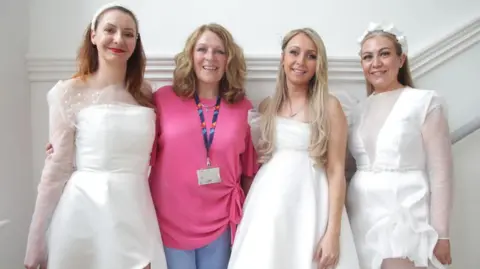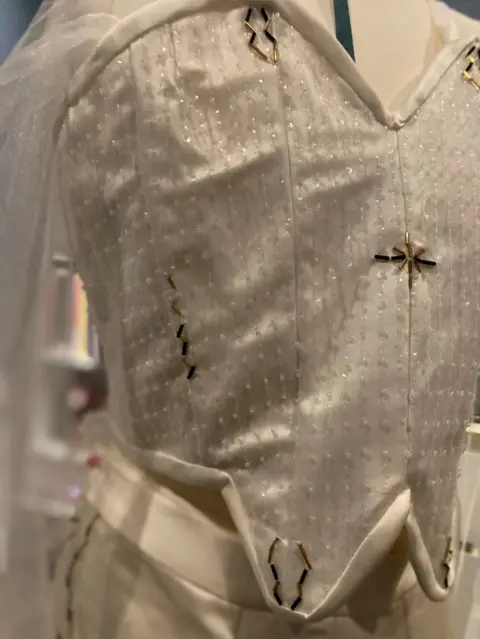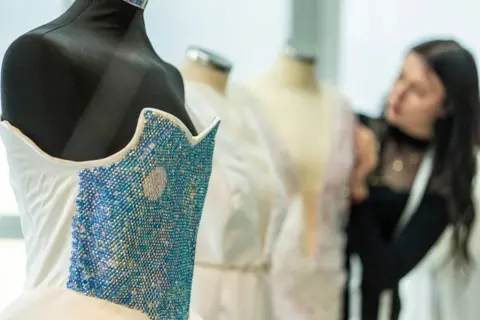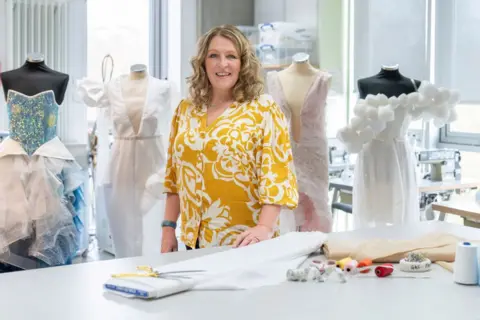
 StoryShop
StoryShop
The designers used second-hand bridal gowns to create new dresses
A project based on repurposing old bridal dresses in Glasgow has won a worldwide sustainability prize.
Glasgow Kelvin College was one of two UK institutions recognised at this year's international Green Gown awards.
The honour is bestowed upon the top eco-friendly projects at colleges and universities around the world.
Students at the college were tasked with unpicking old sample wedding dresses and creating their own, new designs from just the pre-loved fabric.
Designers could only use parts of the old gowns, including buttons and zips, to build their designs from scratch.

 Jo White
Jo White
Jo White joined the course after recovering from a long illness
Jo White, a 46-year-old mum of two, was one of the 16 designers working on the award-winning project.
She decided to join the fashion design course after a long period of ill health.
Jo previously worked as a drug rehabilitation officer, but after a life-saving liver transplant made the decision to pursue a new career.
"I was very ill for a long time and I was housebound," she said.
"I needed to do something I knew I enjoyed because I was so full of anxiety from being poorly.
"I liked sewing so one of my friends said I should apply for my HND and it went really well."

 Jo White
Jo White
Jo designed a modern take on bridal wear with a corset, trousers and cape

 StoryShop
StoryShop
The dresses were inspired on different themes
Jo now studies fashion and business at university after being urged to apply by her college lecturer.
"I owe so much to those women," she added. "And I loved learning about the whole side of manufacturing.
"Bridal garments have so many layers and the best way to understand how they're made is by taking them apart."
The dresses used for the project were donated by Bijoux Bridal in Hamilton which is managed by former student Rebecca Kennedy.

 StoryShop
StoryShop
The designers worked on the dresses over the course of 12 weeks

 StoryShop
StoryShop
Sandra Thomson said it was important to consider the environmental impacts of fashion
Sandra Thomson, the lecturer who ran the project, said the course focused on sustainable or "slow" fashion.
Slow fashion is a more sustainable approach to clothing production which prioritises quality and the environment over speed and low costs.
"There's a lot of people out there who might not wear a second-hand wedding dress," said Sandra.
"But they would probably be quite happy if it was a new dress using fabric from second-hand dresses.
"There's still so much usable fabric in these dresses. From the 10 dresses we were given, the class made 16 new ones.
"And they weren't just customised - the gowns were totally unpicked to the fabric."
Sandra said she was "very strict" and designers were only allowed to use the second-hand dresses throughout the process.
But luckily the original dresses used luxurious material and were worth £25,000.
"It meant the students were able to use really high quality fabrics that they would never have been able to afford otherwise," she added.
"They had to be clever and cut around any marks or make-up in the fabric to make sure they used the very best parts."

 Kelly Carlin
Kelly Carlin
Kelly Carlin said the design process made the students more creative
Kelly Carlin, 20, started studying fashion at the college after she left secondary school at 16.
"Getting to examine and unpick the layers and then totally transform the dresses was amazing," she said.
"The process made us be more creative and we could run wild with our ideas which would prolong the life of these garments.
"If we didn't do that they would've ended up in landfill, but we got so much out of all of them."
The dresses were later displayed at an end-of-year fashion show before the college found out it had been shortlisted for the Next Generation Skills and Learning award.
Lecturer Sandra said: "We went down to the UK final and I was so blown away by the other projects.
"I felt as if we were the wee humble fashion project amongst all these other big projects.
"But we won that - and then we went on to win the international one as well.
"There wasn't an expectation when we got there, but we were absolutely delighted since we're quite a small department."
More stories about sustainable fashion
 4 months ago
288
4 months ago
288



